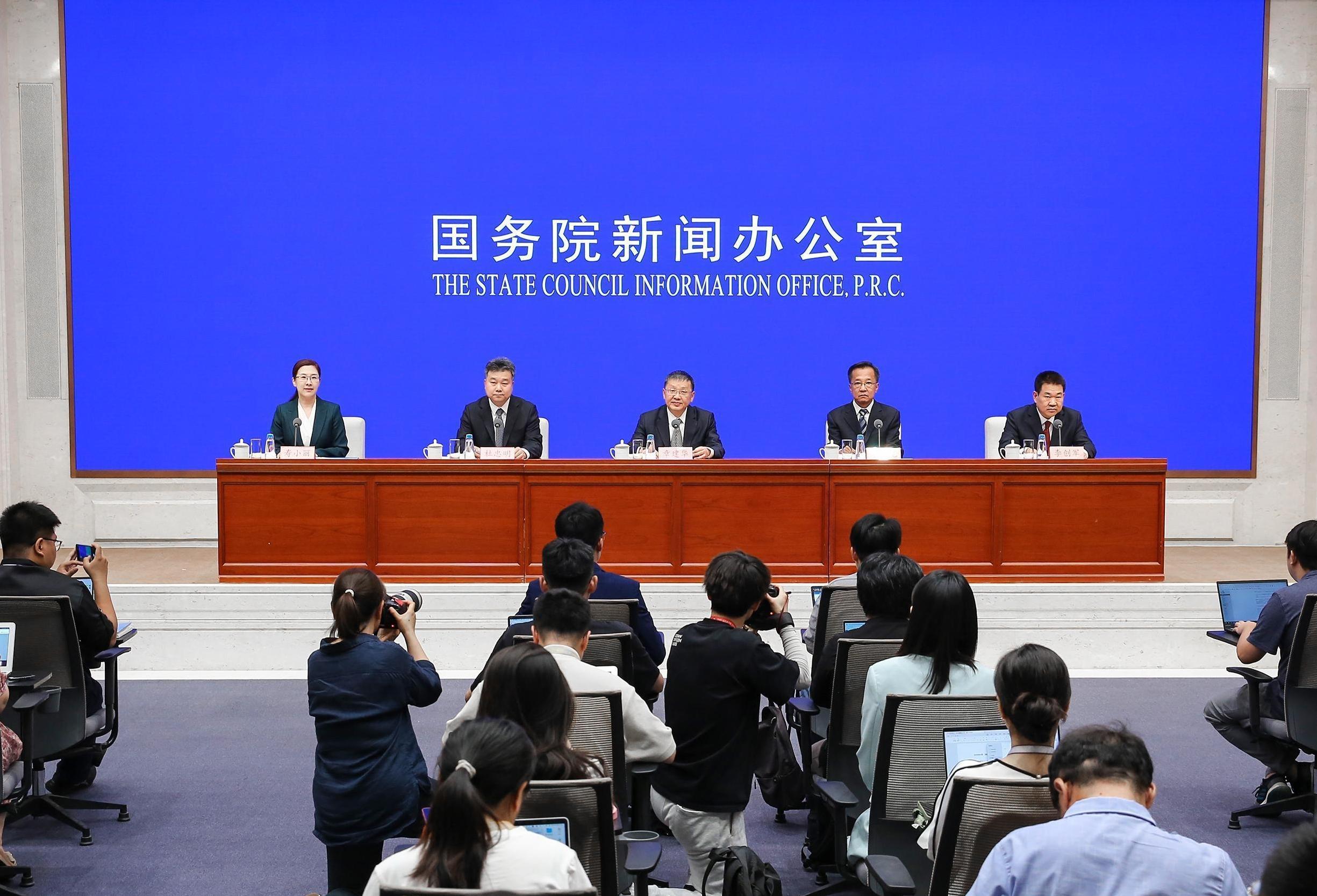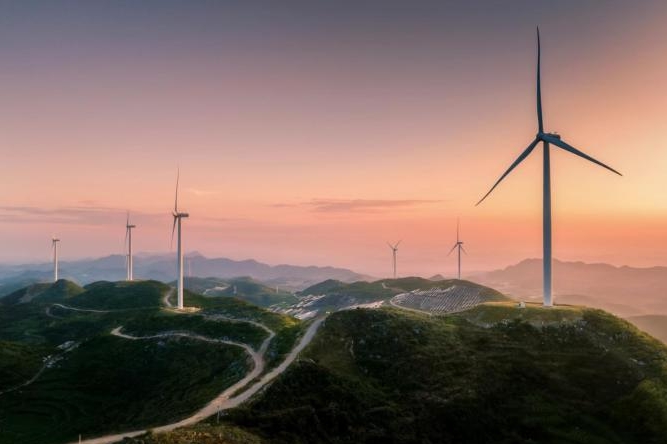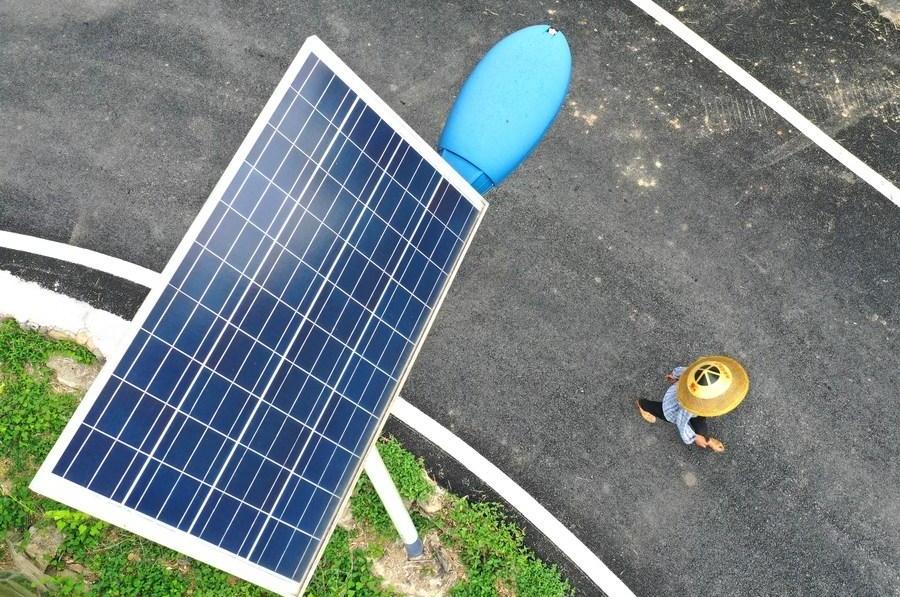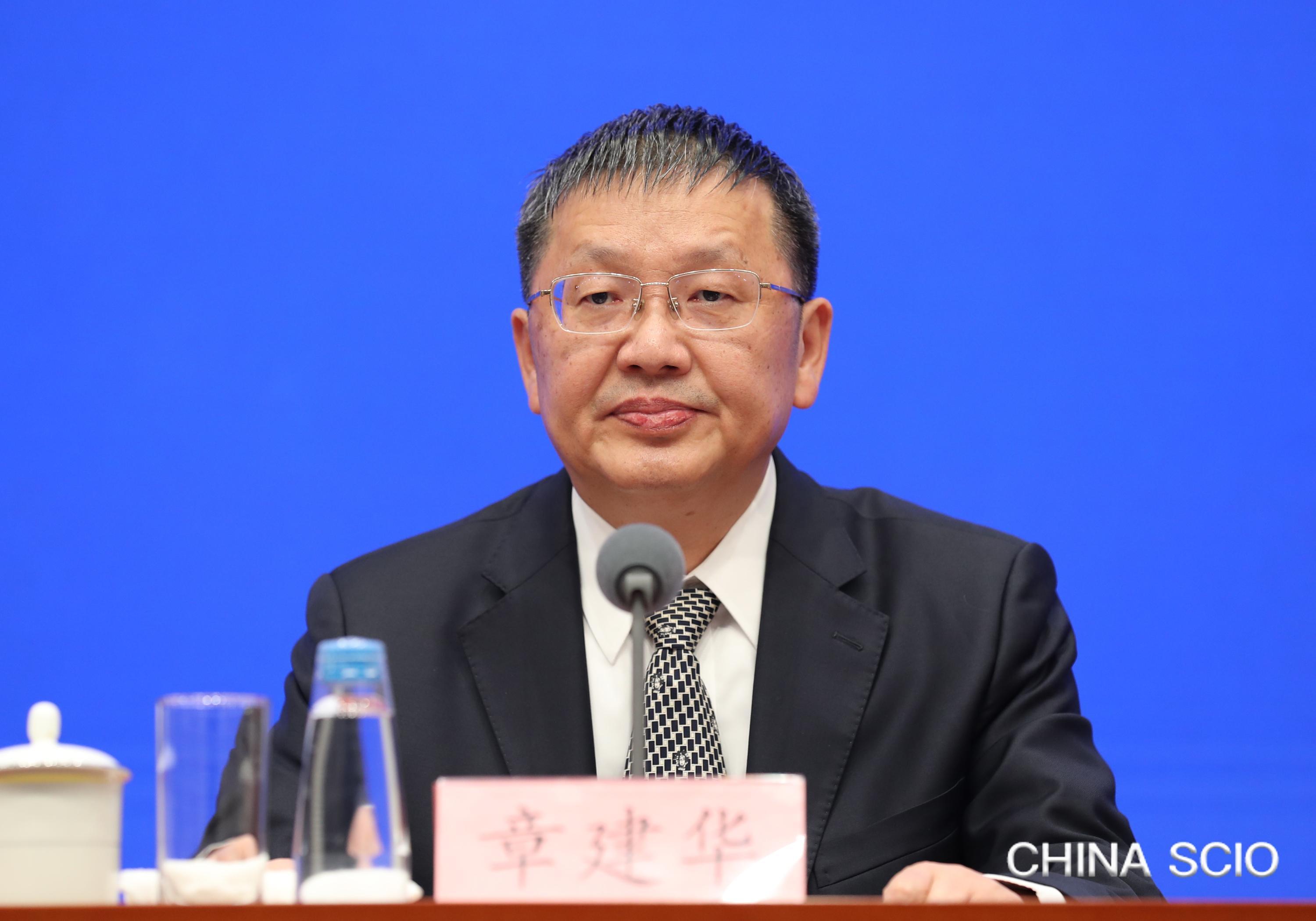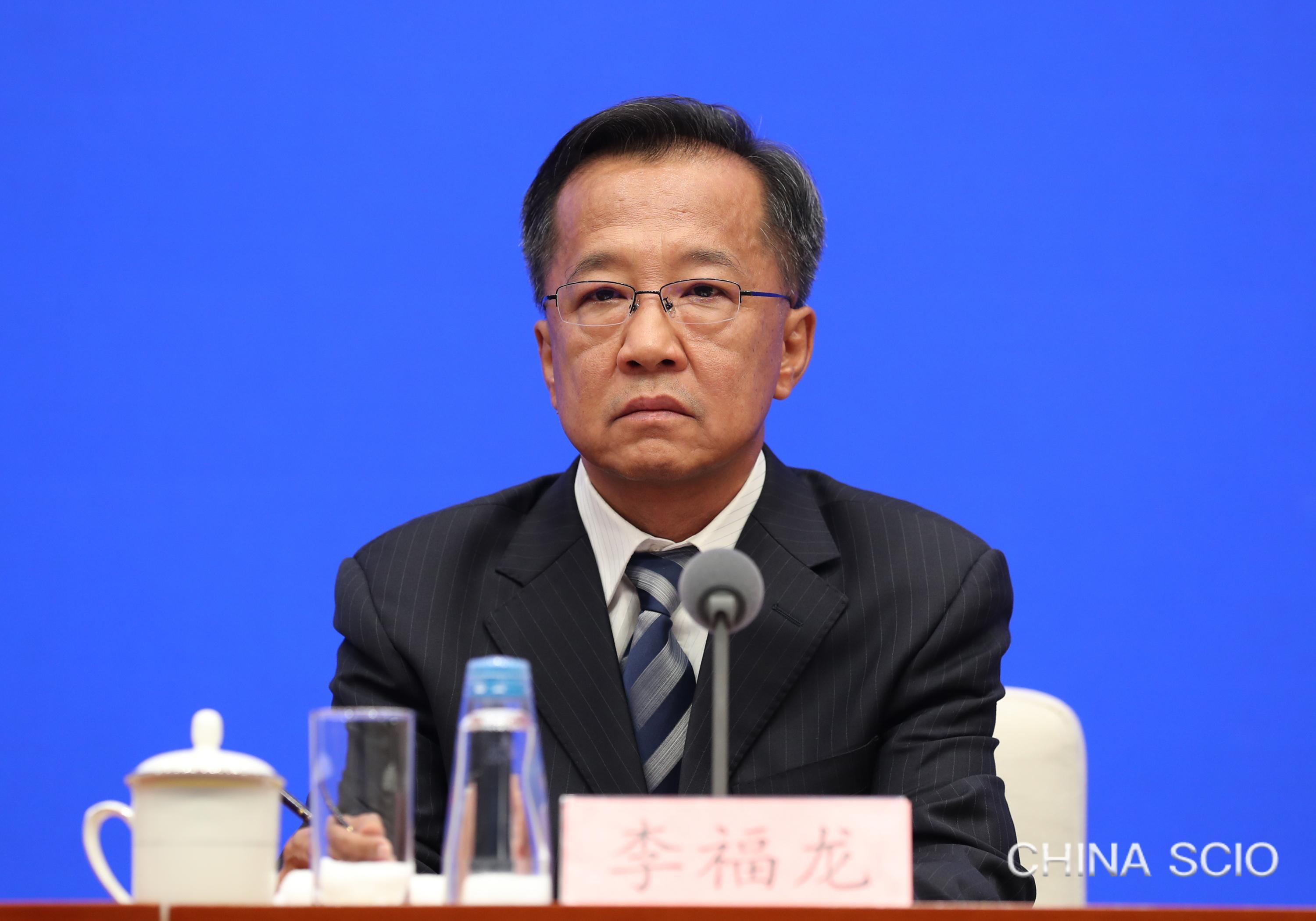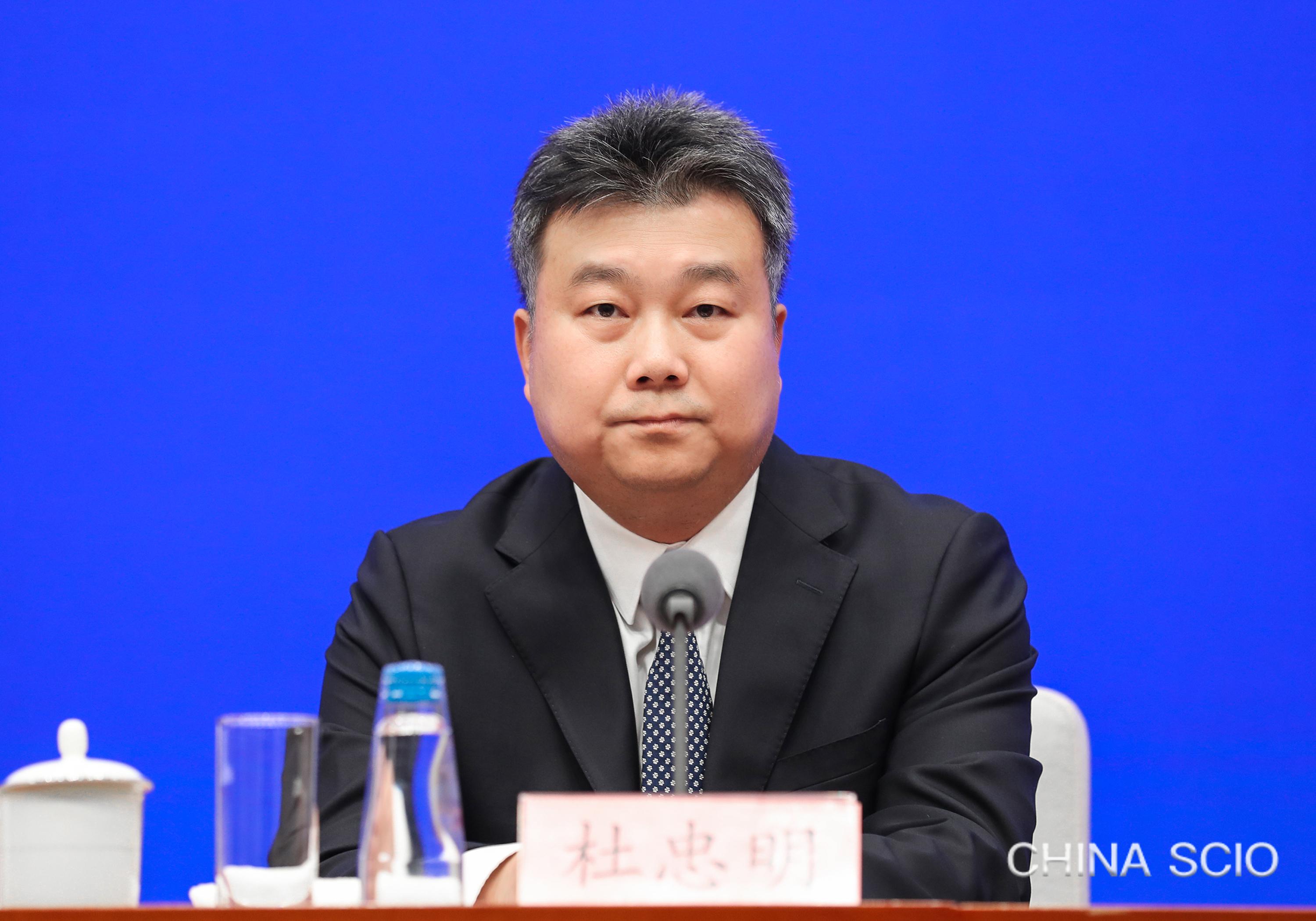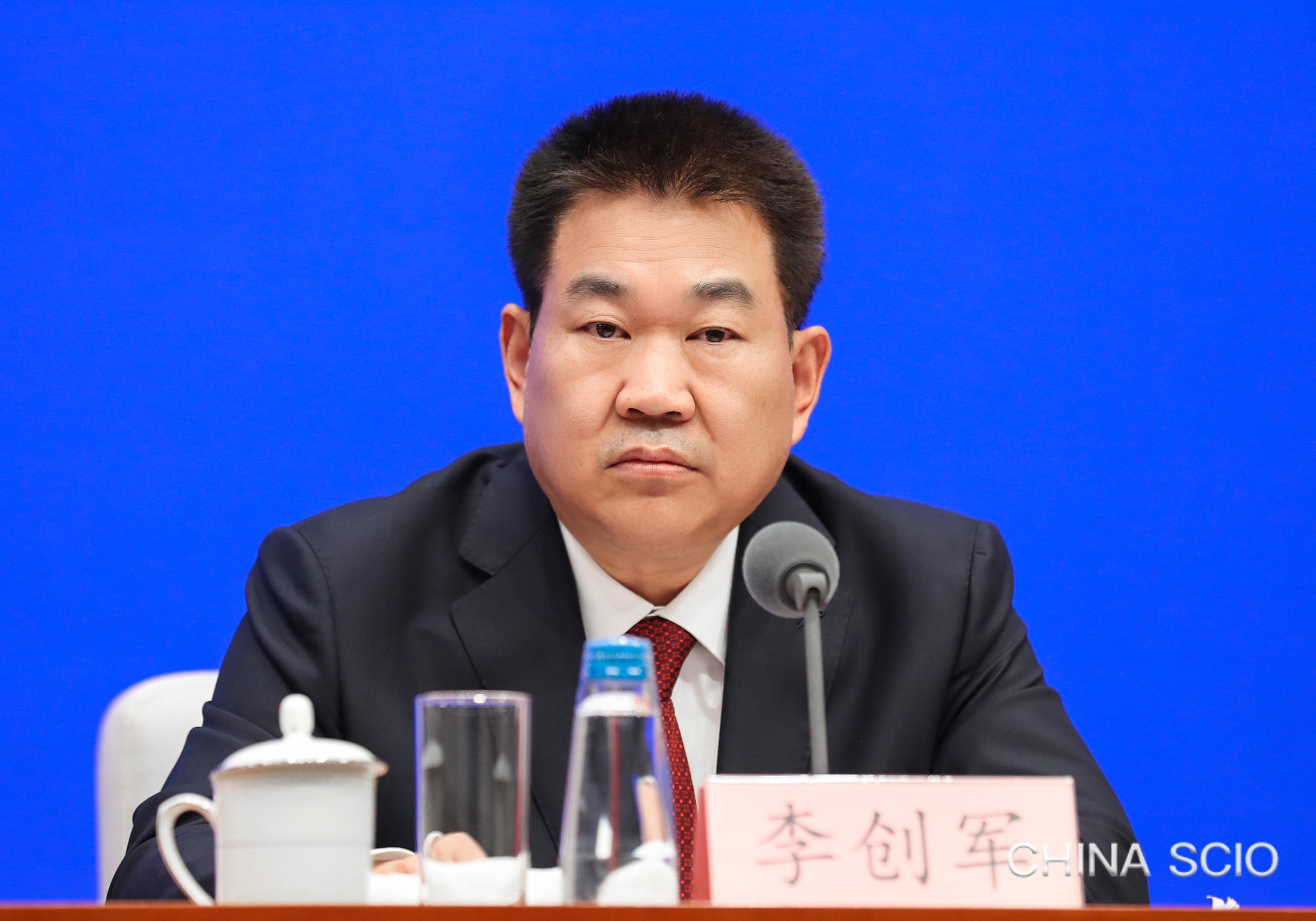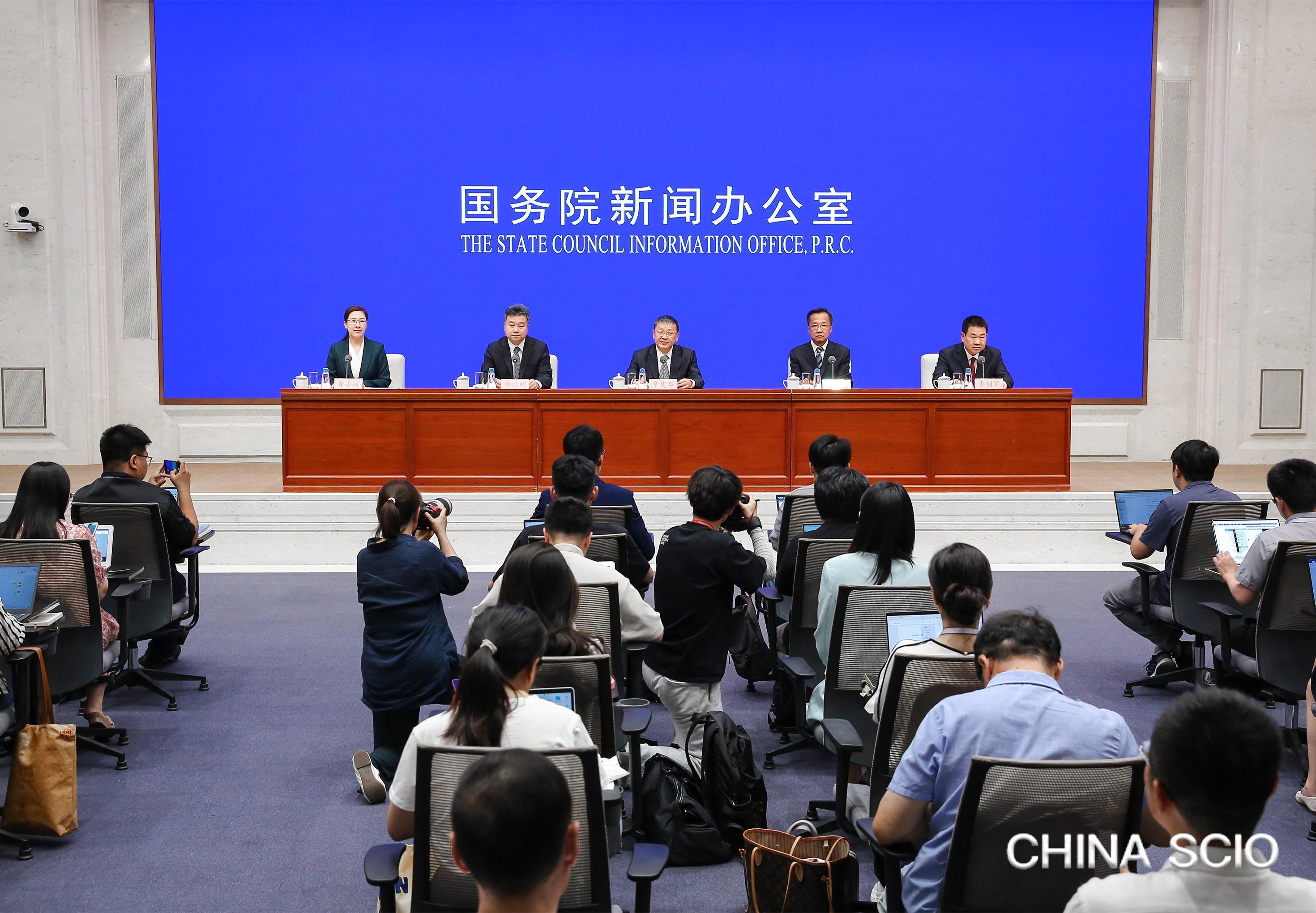Read in Chinese
Speakers:
Mr. Zhang Jianhua, administrator of the National Energy Administration (NEA)
Mr. Li Fulong, director general of the Department of Development and Planning of the NEA
Mr. Du Zhongming, director general of the Department of Electricity of the NEA
Mr. Li Chuangjun, director general of the Department of New Energy and Renewable Energy Sources of the NEA
Chairperson:
Ms. Shou Xiaoli, director general of the Press Bureau of the State Council Information Office (SCIO) and spokesperson of the SCIO
Date:
June 20, 2024
Shou Xiaoli:
Ladies and gentlemen, good afternoon. Welcome to this press conference held by the State Council Information Office (SCIO), as part of the series "Promoting High-Quality Development." Today, we have invited Mr. Zhang Jianhua, administrator of the National Energy Administration (NEA), to brief you on relevant developments and answer your questions. Also present today are Mr. Li Fulong, director general of the Department of Development and Planning of the NEA; Mr. Du Zhongming, director general of the Department of Electricity of the NEA; and Mr. Li Chuangjun, director general of the Department of New Energy and Renewable Energy Sources of the NEA. Now, I'll give the floor to Mr. Zhang for his introduction.
Zhang Jianhua:
Ladies and gentlemen, good afternoon. I am pleased to meet with friends from the media to brief you on implementing the new energy security strategy and promoting high-quality energy development.
Energy is a crucial material foundation and driving force for economic and social development, directly impacting the people's livelihoods and national security. Since the 18th National Congress of the Communist Party of China (CPC), General Secretary Xi Jinping has placed significant emphasis on energy work. In June 2014, he proposed the new energy security strategy, featuring reforms in four main aspects and comprehensive international cooperation, which provides a fundamental guideline for China's high-quality energy development in the new era. Over the past decade, we have vigorously promoted revolutions in energy consumption, supply, technology and institutional frameworks, and strengthened international cooperation in all aspects, achieving historic milestones in energy development. These efforts have strongly supported the building of a moderately prosperous society in an all-round way and the new journey of building a modern socialist country in all respects.
We have actively embraced the concept of green development, fully leveraging the driving role of the transformation on the consumption side. Our energy consumption structure has continuously improved, and green and low-carbon energy development has reached new heights. From 2013 to 2023, the proportion of coal consumption decreased from 67.4% to 55.3%, a cumulative decline of 12.1 percentage points. Non-fossil energy sources, such as wind power, solar power, hydropower, nuclear power and biomass, increased their share from 10.2% to 17.9%, a cumulative increase of 7.7 percentage points. Profound changes have taken place in energy use across industries, transportation, construction and daily life. The quality of petroleum products has been upgraded from "China III" to "China VI" emission standards, significantly contributing to improved air quality. Additionally, we established the world's largest charging infrastructure system, significantly enhancing the environmentally friendly aspects of economic development.
We have adhered to a holistic approach to national security, focusing on enhancing domestic resource production capabilities to ensure our energy independence. The stability and security of our energy supply have reached new heights. From 2013 to 2023, total primary energy production increased by 35%. Raw coal production capacity continued to strengthen, crude oil production remained at 200 million metric tons, and installed power generation capacity and natural gas production doubled. Wind power installed capacity grew from over 76 million kilowatts to more than 440 million kilowatts, increasing nearly fivefold. Photovoltaic power installed capacity expanded from over 19 million kilowatts to over 600 million kilowatts, growing more than thirtyfold. In 2023, the newly installed renewable power generation capacity exceeded half of the global total, with the cumulative installed capacity accounting for nearly 40% of the global share. The capacity for west-to-east electricity transmission exceeds 300 million kilowatts, supporting about one-fifth of the electricity demand in central and eastern China. The total length of long-distance oil and gas pipelines increased from over 100,000 kilometers to 190,000 kilometers, an approximately 80% growth. Per capita household electricity consumption nationwide increased from 500 kilowatt-hours (kWh) to nearly 1,000 kWh, doubling over the period, effectively meeting the energy needs of 1.4 billion people.
We are committed to innovation-driven development, accelerating self-reliance and strength in energy science and technology. Traditional energy industries have been transformed and upgraded, while we fostered competitive advantages in new energy sectors. Our energy technology has reached internationally advanced levels. We developed independent intellectual property rights for third-generation domestically developed pressurized water nuclear technology, including the Hualong One. The commercial demonstration project of the world's first high-temperature gas-cooled reactor in Shidaowan, Shandong province, was completed and put into operation. Breakthroughs were made in unconventional oil and gas exploration and heavy-duty gas turbine development. We maintained a world leading position in technologies like ultra-high voltage power transmission and high-parameter coal-fired power generation. The wind power industry established a comprehensive industrial chain from equipment manufacturing, development and construction to operation and maintenance. The conversion efficiency of photovoltaic cells has set multiple world records, and the costs of wind and solar power generation decreased by 60% and 80%, respectively. Our hydropower industry leads globally, exemplified by the Baihetan hydropower station, which has the world's largest single-unit capacity. The industrialization of cutting-edge technologies like new energy storage and hydrogen energy accelerated.
We continue to deepen reforms, promoting better interplay between efficient markets and well-functioning government. We have improved the legal framework for energy, accelerated the development of the energy market, and enhanced the effectiveness of energy governance. Reforms in key energy areas and critical sectors remain ongoing. Laws and regulations on energy have been strengthened, with a draft energy law undergoing review by the Standing Committee of the National People's Congress, and the revision of the laws on electricity, coal and renewable energy progressing in an orderly manner. A unified national electricity market system is rapidly developing, with over 60% of electricity consumption now subject to market-based transactions. The oil and gas market system is taking shape, and mechanisms for medium- and long-term coal contracts and market pricing are continually improving. The dividends of energy reforms continue to drive vitality among various business entities, providing powerful momentum for high-quality energy development.
We are committed to the vision of building a global community of shared future, expanding high-standard openness in the energy sector, boosting pragmatic international cooperation, and increasing involvement in global energy governance. Energy cooperation with the global community has expanded in all dimensions. Overseas oil and gas cooperation zones and import channels have been further strengthened. Several landmark projects have been completed and started operation, such as the Belo Monte ultra-high voltage (UHV) direct current (DC) transmission project in Brazil and the first overseas Hualong One nuclear reactor in Pakistan. We have achieved electricity interconnection with seven neighboring countries. We established two important diplomatic mechanisms, the Belt and Road Energy Partnership, and the Global Clean Energy Cooperation Partnership. A total of six regional energy cooperation platforms have proven beneficial, including those with ASEAN and the League of Arab States. China has become an increasingly important force in the global energy governance system.
Chinese-style modernization raises new and higher requirements for energy development. We will continue to implement the new strategy for energy security and accelerate the planning and development of a new type of energy system, fully promoting the high-quality development of the energy sector. Thank you.
Shou Xiaoli:
Thank you, Mr. Zhang. The floor is now open to questions. Please identify the news agency you represent before raising questions.
_ueditor_page_break_tag_
Shenzhen Satellite TV:
I have noticed that developing a new energy system has become a hot topic on the internet regarding the energy sector. I'd like to ask, what specifically makes this energy system "new?" What is the current progress in implementing it? Thank you.
Zhang Jianhua:
Thank you for the questions. I will answer them. Developing a new energy system is essential for ensuring national energy security. The report to the 20th CPC National Congress outlined the important strategic decision of moving faster to plan and develop a new energy system. The Central Economic Work Conference has made specific arrangements in this regard for two consecutive years. This is also the overall objective and a strategic task of energy development in the new era. In the past two years, the NEA has thoroughly implemented the decisions and arrangements of the CPC Central Committee and the State Council, made greater efforts to ensure both high-quality development and greater security, deepened understanding of the new energy system in terms of its core meaning and distinctive features, and implemented various tasks and measures through solid efforts. We have made progress in developing the new energy system, encompassing four aspects:
First, the energy landscape has seen a significant shift towards cleaner sources. In recent years, we've rapidly increased our non-fossil energy supply. During the first three years of the 14th Five-Year Plan, annual growth outpaced that of the 13th Five-Year Plan period by 40%. The share of clean energy in total energy consumption rose by 0.7 percentage point each year. Notably, the installed capacity of non-fossil energy power generation has now surpassed that of thermal electricity for the first time.
Second, the energy supply side has become more resilient. In 2023, production of primary energy resources - including coal, oil, and gas - reached 4.83 billion tons of standard coal equivalent. Currently, the country's total installed power generation capacity exceeds 3 billion kilowatts. In recent years, crude oil production has held steady at 200 million tons annually. Natural gas production has increased by more than 10 billion cubic meters each year for seven consecutive years since 2017. Additionally, our capacity to manage energy reserves has continued to improve.
Third, the industrial system has been more advanced. China's new energy power generation technologies now lead the world. The "new three," including photovoltaic cells, have become the new hallmark of China's foreign trade exports. The country also constructed and commissioned its first commercially operated high-temperature gas-cooled reactor. Innovative modes and formats continue to emerge. Smart microgrids have enabled the integrated development of power sources, grids, electricity loads, and energy storage. Meanwhile, virtual power plants are effectively guiding consumers to participate willingly in demand response initiatives.
Fourth, the foundation for energy governance has been strengthened. The draft Energy Law has been submitted to the National People's Congress for deliberation. A multi-layered, unified electricity market system is being developed step by step. The regulatory system for natural monopolies in the energy sector has been improved. Key policies and mechanisms have been fully implemented, including the issuance of green power certificates and the renewable energy consumption responsibility weighting system.
Next, we will intensify our efforts to build a new energy system, prioritizing energy security and rapidly developing a diverse energy supply system. We will focus on reshaping the energy demand and supply model, creating synergy in transforming consumption patterns, and accelerating the development of new quality productive forces in the energy sector.
_ueditor_page_break_tag_
Red Star News:
As the meteorology agency predicts, most parts of China will experience higher temperatures this summer than previous years. It will likely be a challenge to ensure power supply and meet peak demands on hot summer days. What is your plan for ensuring a stable power supply during extreme weather? How will you satisfy residential electricity demands? Thank you.
Zhang Jianhua:
Mr. Du, please answer these questions.
Du Zhongming:
Thank you for the questions. As you have seen, many parts of China have recently endured higher temperatures. Since the beginning of this year, electricity consumption has continued its rapid growth momentum. From January to May, total electricity consumption reached 3.84 trillion kilowatt-hours, up 8.6% year on year. This summer, the electricity load of the whole country will increase rapidly, and the maximum load is expected to rise by more than 100 million kilowatts year on year. After comprehensive analysis, we project that during the peak summer season, the overall power supply in the country can be ensured. However, certain areas may face tight supply during peak hours. Extreme weather events or natural disasters could further exacerbate this situation.
The NEA aims to ensure a flexible and reliable power supply under normal conditions, with measures to address short-term local shortages and contingency plans for extreme situations. We will work to ensure that all those involved fully shoulder their share of responsibilities and strive to maintain a safe and stable power supply during peak summer periods. We will take the following measures:
First, we will strengthen monitoring and early warning. We have released the forecast for electricity supply and demand during the 2024 peak summer season. Additionally, we will introduce province-specific policies, guiding key provinces and related enterprises to prepare in advance. Currently, we monitor daily electricity consumption, coal supply, and power generation capacity nationwide and in key regions, promptly addressing any issues that arise. This approach proved effective last year. In May 2023, through full efforts in organization and coordination, Yunnan's coal power plants under central dispatch operated at full capacity, achieving the highest monthly electricity generation in a decade. This strategy effectively offset the drought-induced hydropower shortages, securing a stable power supply in the lead-up to the flood season.
Second, we will fully utilize the power system's capacity during peak demand periods. We will guide power grid companies in optimizing their dispatch and operation schedules, ensuring smooth transmission from power plants to users. By leveraging regional differences in peak electricity hours, we can balance supply and demand across areas and provinces, enabling regions with surplus power to support those experiencing shortages. Additionally, we will optimize the coal power capacity pricing assessment mechanism to fully incentivize coal power plants to increase electricity generation as needed, ensuring they operate at maximum capacity and stability to meet peak demand requirements.
Third, we will accelerate the development of supporting power sources. We are pushing for supporting power projects, such as the second phase of the Banji Power Plant in Anhui and the fifth phase of the Dalad Power Plant in the Inner Mongolia autonomous region, to be completed and put into operation on schedule.
Finally, we will guide local governments in refining their work plans. We will enhance and precisely implement load management measures to avoid power cuts, ensuring that everyone's basic daily electricity needs are consistently met. Thank you.
_ueditor_page_break_tag_
CCTV:
We recognize that economic and social development across all sectors is inextricably linked to how we utilize energy. Considering our dual carbon goals, how can we coordinate the high-quality development of our energy sector, and which key areas should we focus our efforts on? Thank you.
Zhang Jianhua:
Thank you for your question. I will answer it. As you mentioned, energy acts as the fundamental material prerequisite for economic and social development. China's energy supply has grown by nearly 20% since the start of the 14th Five-Year Plan period, effectively supporting the rapid growth in energy demand for the economy and people's livelihoods. With the advancement of new industrialization and urbanization, China's energy demand is expected to continue rising, which requires a reliable energy supply. At the same time, energy development must adhere to the dual carbon goals, including increasing the share of non-fossil energy consumption in primary energy consumption to around 25% by 2030 and lowering carbon emissions per unit of GDP by over 65% compared to 2005 levels. The fundamental task for high-quality energy development in the coming period is to accomplish the dual carbon goals in an orderly and steady manner while effectively safeguarding reasonable energy needs for economic and social development.
To achieve these goals, we will coordinate energy security and low-carbon transition, working on both the supply and demand sides to promote high-quality energy development. First, on the demand side, we will focus on energy-saving and carbon reduction. We will implement the action plan for energy conservation and carbon reduction during 2024-25. Efforts will be made to reduce fossil energy consumption, replace it with alternative energy sources, and strictly control coal consumption. We will continue to promote the transformation and upgrading of energy use, deeply advance the adoption of clean electricity in industries, construction, transportation, and agriculture, and enhance electric vehicle charging infrastructure. By 2025, we aim to build around 12 million charging stations nationwide and increase the electrification rate of terminal energy use to about 30%. Second, on the supply side, we will focus on increasing the quality and quantity of non-fossil energy. We will intensify the development of non-fossil energy sources, coordinating the development and utilization of nuclear power, hydropower and new energy. We will optimize the regulation capability of the power system to improve the grid's ability to accept, allocate, and regulate clean energy. At the same time, we will facilitate the issuance and trading of renewable power and green electricity certificates to promote the growth of green power consumption. Efforts will be made to ensure the increase in energy demand is increasingly met by non-fossil energy sources, with an aim to increase the share of non-fossil energy consumption by 1 percentage point each year.
_ueditor_page_break_tag_
Bloomberg:
I have two questions about solar power. My first question is about solar power companies. They have been handling some financially difficult times. Some, including, Trina Solar, have asked for the government intervention to help control capacity expansion in this industry. Is there anything that the government can do to help out that important industry? Secondly, China has added so much solar power in recent years that certain regions are seeing higher curtailment rates. Is there anything that the government is doing to try to increase solar adoption, whether through power market reforms or other measures? Thank you.
Zhang Jianhua:
This question goes to Mr. Li.
Li Chuangjun:
Thank you for your question. As a clean energy source, solar energy is gaining increasing attention worldwide. Currently, competition in China's photovoltaic (PV) industry is indeed very intense. To guide the healthy development of the industry, we will take the following measures:
First, we will consolidate the newly installed domestic PV power generation market. A stable domestic market is the bedrock and anchor for the sustainable and healthy development of China's PV industry. We will focus on both centralized and distributed development. On the one hand, we will strengthen the construction of large-scale wind power and PV bases in desert, Gobi, and barren regions. On the other hand, we will steadily implement the "Light Up Thousands of Households Initiative," vigorously developing distributed PV power generation. Additionally, we will accelerate the construction of new energy infrastructure networks to enhance the grid's capacity to accommodate, allocate, and regulate new energy power generation, including PV power.
Second, we will enhance interdepartmental coordination to regulate the PV power generation industry. We will work with relevant departments to organize industry associations to quickly release information about industrial scale, capacity utilization rates, and market demand. This will help guide the construction and release of upstream PV production capacity, avoiding repetitive low-end capacity construction and creating a healthy market environment.
Finally, we will continue to enhance PV technology innovation capabilities. We will fully leverage the leading role of the national energy research and development innovation platform, directing resources to support the research and innovation of advanced technologies and capacities. This includes promoting breakthroughs in key technologies for high-efficiency solar cells and advancing technology upgrades in key basic materials. Additionally, we will work with relevant departments to strengthen the development of the PV industry standards system. Through reinforcing standards and promoting innovation, we hope to promote the healthy development of the industry.
Regarding your second question, it is true that with the large-scale and rapid growth of new energy, including PV power generation, the transition to clean and low-carbon energy has accelerated in recent years. However, the characteristics of energy supply and demand have also changed. To better promote new energy development, we will actively advance the construction of the electricity spot market to facilitate the generation of time-based price signals that more accurately reflect electricity supply and demand. Six regions, including Shanxi, Guangdong, Shandong, Gansu, western Inner Mongolia, and Hubei, have implemented measures to guide users to consume more electricity during peak new energy production periods through price signals. Additionally, we will further expand spot market coverage, steadily and orderly promote the participation of new energy in the electricity market, and encourage new energy consumption and the sustainable, healthy development of the new energy industry through effective market mechanisms. Thank you.
_ueditor_page_break_tag_
South China Morning Post:
As China progresses towards the dual carbon goals of peaking carbon emissions by 2030 and achieving carbon neutrality by 2060 and the objective of building a new power system with new energy as the mainstay, the proportion of new energy in the power grid system is gradually increasing. However, this also brings various challenges, including the excessive distributed PV installations in some regions. This leads to reverse power flow and affects grid stability. What measures will be taken to promote the utilization and integration of renewable energy power generation? Thank you.
Zhang Jianhua:
Thank you for your question. I will invite Mr. Du Zhongming to answer it.
Du Zhongming:
Indeed, the issue you raised is very important, and we are continuously strengthening monitoring and conducting in-depth research. As Mr. Zhang Jianhua mentioned, China's installed power capacity has reached 3 billion kilowatts. Last year, the installed capacity of non-fossil energy in China exceeded 50%, historically surpassing the installed capacity of fossil energy. With the further acceleration of new energy development, by the end of April this year, the cumulative installed capacity of wind and PV power generation in China exceeded 1.1 billion kilowatts, a year-on-year increase of about 38%, significantly increasing the demand for utilization and integration. To improve the power system's ability to accommodate new energy, we need to accelerate the construction of supporting grid projects for new energy and urge grid companies to optimize grid connection processes. This year, we are focusing on promoting the construction and commissioning of 33 key projects, including the Sichuan-Chongqing 1,000kV ultra-high voltage (UHV) alternative current (AC) project and the Qinghai Hongqi 750kV transmission and transformation project. Additionally, we will accelerate the construction of 37 key projects, including the Shaanbei-Anhui UHV direct current (DC) project and the Gansu-Zhejiang UHV DC project, to provide strong support for new energy consumption. Furthermore, we are actively promoting the adjustment of system regulation capabilities and the coordinated development of grid sources. We will maximize the role of the power grid as a resource allocation platform, flexibly adjust the mode of dispatch and operation, and enhance inter-provincial mutual assistance and resource-sharing capabilities. In addition, we have optimized the new energy utilization rate targets, allowing for more flexible targets for some areas with favorable resource conditions, but generally not lower than 90%, and we conduct dynamic assessments based on the annual consumption situation. While enhancing the consumption capacity of the power grid, we have also proposed measures to improve the comprehensive carrying capacity of the distribution network. Regarding the distributed PV challenges you mentioned, they mostly occur on the distribution network side. To meet the requirements of large-scale development of distributed new energy, we will strengthen the construction and transformation of the distribution network, build a strong and flexible grid structure, enhance the level of intelligence, and improve the dispatch operation mechanism. By 2025, the distribution grid will be able to accommodate about 500 million kilowatts of distributed new energy.
Next, we will focus on constructing a new power system. We will guide local energy authorities, power enterprises, and various dispatched agencies to earnestly implement relevant requirements. We will adopt multiple measures to ensure the effective accommodation of new energy power, promote the construction of a new energy supply and consumption system, and provide solid support for the high-quality development of new energy.
Thank you!
_ueditor_page_break_tag_
Jinan Times:
Coal is currently the mainstay of China's energy supply, serving as a crucial guarantee for energy security and a key raw material for industrial production. As the world's largest energy producer and consumer, could you please provide an update on the high-quality development of coal in China? Thank you.
Zhang Jianhua:
I will hand this question to Mr. Li Fulong.
Li Fulong:
Thank you for your important question. Coal remains the main energy source in China, playing dual roles as a significant fuel and industrial raw material. Use of coal provides a solid footing for ensuring national energy security. Over the past decade, we have balanced development and security, continued to develop digital and smart coal mines, rationalized the expansion of advanced capacity, and strengthened the clean and efficient utilization of coal. The high-quality development of coal industry has been cemented, providing a solid foundation for ensuring national energy security.
This is reflected in four aspects:
First, coal supply security has been continuously enhanced. Coal development has increasingly gravitated towards resource-rich and competitive western regions. Raw coal production in Shanxi, Shaanxi, Inner Mongolia and Xinjiang increased significantly from 2.59 billion tons in 2013 to 3.83 billion tons in 2023, with the share in national output up 11.8 percentage points, playing a leading role in coal supply. Large-scale modern coal mines now dominate production, reducing the number of mines from over 10,000 to about 4,200.
Second, there have been notable achievements in green and intelligent coal development. Environmentally friendly coal exploitation technologies have been widely applied, leading to marked improvements in ecological conditions at mines. The mine water comprehensive utilization rate and land reclamation rate both rose by more than 10 percentage points. The intelligent construction of coal mines has entered a new phase of accelerated and deepened development. As of the end of May 2024, investments in intelligent coal mine construction have exceeded 112 billion yuan. Nationwide, 1,993 intelligent coal mining faces and 2,232 intelligent heading faces have been developed, effectively reducing manpower while improving safety and efficiency. Preliminary statistics show that key coal mines have reduced single-shift personnel at smart mining faces by more than six people, with work efficiency increasing by over 20%, marking a significant transformation in coal production methods.
Third, clean and efficient coal utilization has seen continuous improvements. Efforts have been made to enhance coal washing and dressing capabilities. The commercial coal quality evaluation and management criterion have been improved continuously, prompting steady upgrades of coal quality. Meanwhile, in the electricity sector, which is the primary field of coal consumption, efforts to phase out outdated coal-fired units have been coordinated with reforms to save energy, reduce carbon emission, improve flexibility, and renovate heat supply system. As of the end of last year, over 95% of coal-fired units have achieved ultra-low emissions, and China has established the world's largest clean coal-fired power supply system. Key breakthroughs have also been achieved in coal-to-oil and coal-to-gas technologies and equipment, continuously optimizing related operation indices.
Fourth, there has been leapfrog development in coalbed methane (CBM), or coalmine gas, exploitation and utilization. The coal industry has continued to promote comprehensive CBM governance, demonstrating significant economic, social, and ecological benefits. The CBM industry has realized large-scale development. Two major industrial bases have been established in the Qinshui Basin and the eastern margin of the Ordos Basin. National CBM production reached 11.77 billion cubic meters in 2023, nearly quadrupling the 2013 level, serving as a significant supplement to the natural gas supply. Thank you!
_ueditor_page_break_tag_
Cnr.cn:
My question is still about renewable energy. Mr. Zhang just mentioned that China's contribution exceeded half of the newly installed global renewable energy capacity in 2023. Furthermore, China's wind power and photovoltaic products have been exported to more than 200 countries and regions worldwide. I'd like to ask: What experiences have we gained in promoting the utilization of renewable energy? Thank you.
Zhang Jianhua:
Thank you. I'll invite Mr. Li Chuangjun to answer this question.
Li Chuangjun:
Thank you for your question. Since the 18th National Congress of the CPC, General Secretary Xi Jinping has on many occasions made important instructions on the development of renewable energy. Guided by the new energy security strategy of "Four Revolutions and One Cooperation," our country's renewable energy development has achieved leapfrog progress, moving from small-scale to large-scale, and from catching up to leading the way. China's renewable energy development has garnered worldwide attention. Here are the main experiences we've gained:
First, we have benefited from vast market potential. As the world's largest energy producer and consumer, our country has enormous power demand and a strong need for new installed capacity. This vast space has provided ample opportunities for renewable energy development in China. As Mr. Zhang mentioned, of the 510 million kilowatts of the global renewable energy capacity additions in 2023, China's contribution exceeded 300 million kilowatts, surpassing the rest of the world combined.
Second, we have benefited from proactive policy support. Since the implementation of the Renewable Energy Law, a comprehensive policy support and regulatory system for renewable energy has been gradually established, encompassing laws and regulations, strategic planning, industrial policies, standard systems, and supervision and management.
Third, we have benefited from timely policy adjustments. We have promptly adjusted and improved support policies. In the early stages, we reduced the price of on-grid electricity for new energy generation projects annually based on technological advancements and cost reductions in wind power and photovoltaics. For example, the benchmark on-grid electricity price for photovoltaics in Class III resource areas in 2020 was 0.06 yuan lower than in 2019. In recent years, we have gradually shifted the development of the new energy industry from policy-driven to market-driven, vigorously promoting wind power and photovoltaics into a new development stage and having achieved grid parity through competitive allocation.
Fourth, we have benefited from extensive market participation. New energies like wind power and photovoltaics enjoy a high degree of marketization, with an open market environment, diverse market entities, active private enterprises, sufficient market competition, and vibrant innovation. Taking photovoltaics as an example, there are over 100 listed companies in China's photovoltaic industry.
Fifth, continuous technological innovation has been key. Our country's renewable energy industry has consistently pursued technological innovation, satisfying ever-changing market demands through accelerated iterations of technology and products. Currently, China's wind power sector has reached an internationally advanced level in areas such as large-scale turbines and floating units. Crystalline silicon photovoltaic technology continues to upgrade, further consolidating and enhancing China's leading position internationally. Thank you.
_ueditor_page_break_tag_
Tide News:
Recently, we've heard some Western countries hyping up the issue of "overcapacity" in China's new energy sector, claiming that China's new energy exports are impacting international markets. Could you please comment on this from the NEA's perspective?
Zhang Jianhua:
Thank you for your question. Mr. Li has just introduced some data on our country's new energy development, from which I believe many conclusions can be drawn. China's new energy industry has proven its true capabilities through open competition and represents advanced production capacity. It has not only enriched global supply and alleviated international inflationary pressures but also made significant contributions to global climate change mitigation and green transformation. This achievement has been fully recognized by the global energy industry. From both the perspectives of comparative advantages and global market demand, China's new energy industry does not face the so-called "overcapacity" issue.
In the context of economic globalization, we should adhere to the principles of a market economy and the law of value when addressing issues of production capacity. The balance between supply and demand is inherently relative, often characterized by imbalance as the norm. This dynamic is common in market economies, where moderate oversupply can drive technological advancement and industry-wide cost reductions. The primary solution to addressing these issues lies in allowing the market to adjust in accordance with the law of value.
Take photovoltaics as an example. On one hand, the global photovoltaic industry is experiencing a prosperous growth cycle, with companies eager to expand their production capacities. According to estimates by the International Renewable Energy Agency, to achieve the goals of the Paris Agreement, the cumulative global installed capacity of photovoltaics is projected to surpass 5.4 billion kilowatts by 2030, nearly quadrupling the capacity installed by 2023. Therefore, the development prospects are very promising. In China, the upstream photovoltaic industry is predominantly composed of highly competitive private companies. Due to optimistic expectations for future market growth, these companies are actively expanding their production capacities. On the other hand, the adoption of new technologies and the phase-out of outdated capacities require time. Technological advancements in the photovoltaic industry have been rapid, stabilizing new technological pathways since 2023 and notably reducing investment costs in production capacity equipment. Companies are continuously commissioning advanced capacities to maintain overall market competitiveness. Meanwhile, outdated capacities still exist on a large scale and need to be gradually phased out. During the transition period of technological pathways, the coexistence of new and old capacities has also increased the overall industry capacity. Additionally, some companies need to enhance their core competitiveness. In the context of the industry's continuous technological development, some companies have gradually lost market competitiveness due to a lack of ability to continuously optimize processes and upgrade production lines. Moving forward, we will proactively collaborate with relevant departments to regulate the orderly development of the photovoltaic industry and promote its healthy and sustainable growth.
Furthermore, I would like to emphasize that the essence of international cooperation lies in complementary advantages and mutual benefits. There are broad common interests and significant international cooperation opportunities among all parties in the green transition. Therefore, China aims to collaborate with all parties to uphold the basic principles of fair competition and open cooperation in a market economy. Together, we strive to enhance our clean energy industry and supply chains, share knowledge and experiences, and contribute significantly to the global green and low-carbon transition. Thank you.
_ueditor_page_break_tag_
Nanfang Daily:
Recently, the State Council issued an action plan for energy conservation and carbon reduction during 2024-25. Could you please provide us with an update on the progress made in promoting energy conservation and carbon reduction within the energy sector? What are the key measures planned moving forward? Thank you.
Zhang Jianhua:
I would like to invite Mr. Li to answer this question.
Li Fulong:
Thank you for your question. The issue you have raised is very important. Energy conservation and carbon reduction are vital steps in actively and steadily achieving carbon peaking and carbon neutrality, comprehensively advancing the Beautiful China Initiative, and promoting the comprehensive green transformation of economic and social development. Over the past decade, under the guidance of General Secretary Xi Jinping's new energy security strategy of "Four Reforms and One Cooperation," which focuses on energy consumption, supply, technology and system reforms and international cooperation, China has significantly improved its energy utilization efficiency, positioning itself as one of the world's leaders in reducing energy intensity. At the same time, we must recognize that China faces significant pressure from energy demand, and the challenges of energy conservation and carbon reduction are formidable. Currently, China's per capita energy consumption is only about two-thirds of the average level of OECD countries, and energy demand will continue to grow steadily in the foreseeable future. According to the requirements of balancing energy security and low-carbon transformation, we need to continue to make coordinated efforts from both the supply and consumption sides to promote energy conservation and carbon reduction with greater intensity.
On the one hand, we need to increase the supply of non-fossil energy on the supply side. This involves accelerating the construction of large wind power and photovoltaic bases, actively and safely developing nuclear power in an orderly manner, promoting offshore wind power development and construction, and coordinating the integrated development of hydropower, wind power, and photovoltaic power in major river basins. We also need to vigorously develop distributed renewable energy systems. Additionally, we will advance the construction of new energy infrastructure networks to improve the grid's ability to accept, allocate, and regulate clean energy. By 2030, 70% of the increase in energy consumption will be met by non-fossil energy.
On the other hand, we will enhance the level of green and low-carbon energy use on the consumption side. This includes supporting key industries in implementing energy conservation and carbon reduction measures, innovating energy supply and consumption models in industrial parks, and continuing to vigorously expand electric vehicle charging infrastructure. We will also take various measures to promote the electrification of sectors such as industry, construction, and transportation. By 2025, the electrification level of terminal energy consumption is expected to reach approximately 30%. We will continue to enhance the issuance of green certificates and strive to ensure green certificates are available for all renewable energy projects, including wind power, solar power, and biomass power, as early as possible. Additionally, we will enhance the green certificate trading mechanism to promote the expansion of green energy consumption across society. Thank you.
_ueditor_page_break_tag_
21st Century Business Herald:
You have just mentioned the continuous increase in the installed capacity of new energy. We believe that developing new ways of storing energy is also very important. The Report on the Work of the Government this year also, for the first time, proposed the creation of new energy storage methods. Could you please provide an update on the current progress of new types of energy storage projects? What additional work is needed to further develop new types of energy storage across China? Thank you.
Zhang Jianhua:
We will have Mr. Li Chuangjun answer this question.
Li Chuangjun:
Thank you for your question. New types of energy storage are a crucial component of both new power and new energy systems. They are key supporting technologies in China's efforts to build these new systems. Their development can drive the growth of upstream and downstream industrial chains and promote scientific and technological innovation, talent cultivation, and investment and employment. They have become one of the new growth drivers for the development of new quality productive forces.
As of the end of May this year, China's installed capacity of new energy storage projects that had been constructed and put into operation exceeded 38 million kilowatts, with an average storage duration of 2.2 hours. There are 12 provinces and regions with an installed capacity of over 1 million kilowatts. New energy storage technologies continue to emerge, with a diverse range of technological approaches flourishing. Currently, lithium-ion battery storage still holds the dominant position and is widely applied in new energy power stations, substations and industrial parks. In addition, technologies such as compressed air energy storage, flow battery energy storage, and flywheel energy storage are also developing rapidly. Several large-scale projects are under accelerated construction, including 300,000-kilowatt class compressed air energy storage projects, 100,000-kilowatt class flow battery storage projects, and megawatt-level single-unit flywheel energy storage projects. New technologies, such as gravity energy storage, liquid air energy storage, and carbon dioxide energy storage, are also being implemented. Overall, the field is demonstrating a trend of diversified development.
Next, the NEA will strengthen the tracking of new types of energy storage pilot demonstrations and advance innovation in new energy storage technologies. We will enhance the mechanisms for grid connection, dispatch and operation of new energy storage systems while promoting their regulatory role. We will proactively plan and strengthen top-level design, promote the scientific and efficient allocation of new energy storage in new energy bases, and promote the high-quality development of the new energy storage industry. Thank you.
_ueditor_page_break_tag_
Shou Xiaoli:
One last question, please.
The Poster News APP:
When it comes to energy, the general public is most concerned about whether there's enough electricity and natural gas for their homes. What specific measures has China taken to ensure energy supply for people's basic needs since the proposal of the new energy security strategy? Thank you.
Zhang Jianhua:
Thank you for your question. People's direct experience of high-quality energy development is that their energy needs have been met, and the quality of energy use has improved. In recent years, the NEA has upheld a people-centered approach, safeguarding energy supply for basic needs and continuously improving people's sense of fulfillment.
The quality and level of general energy services have greatly improved. China's natural gas consumption rose from 170.5 billion cubic meters in 2013 to over 390 billion cubic meters in 2023, ensuring natural gas supply for people's basic needs. The construction and upgrading of rural power grids have been vigorously advanced. By the end of 2015, all people in China had gained access to electricity, with China leading developing countries in achieving universal electricity access. By the end of 2020, the large power grid covered all counties nationwide, and villages within its coverage were provided with three-phase power, effectively ensuring power supply for rural production and life. Priorities have been given to ensure power supply for people's basic needs. We have guided local governments to unlock potential in demand response from the supply side and optimized power curb measures based on industrial structures, ensuring that electricity use for people's basic needs and important users is not affected. According to the World Bank's Business Enabling Environment assessment, China ranks 12th globally in the "Getting Electricity" indicator.
We have actively responded to people's expectations and needs for energy use in green living. We've promoted clean winter heating in northern China, tailored to local conditions, rapidly increasing the proportion of clean energy heating and significantly improving residential heating conditions. Charging infrastructure has developed rapidly, with nearly 10 million charging points for electric vehicles built. More than 95% of expressway service areas are now equipped with charging facilities. China has developed a charging infrastructure system with the largest number of facilities, the widest range of services, and the most complete types of charging facilities, supporting the energy needs of over 20 million new energy vehicles in China.
Energy projects have contributed to poverty alleviation and rural revitalization. Projects featuring comprehensive and complementary utilization of diverse energy sources, including photovoltaics, biomass energy and energy storage, have been built in agricultural industrial parks and villages where conditions allow. Poverty-alleviation photovoltaic power stations have been constructed and put into operation, with a total installed power-generating capacity of 26.36 million kilowatts. These stations generate an annual revenue of 18 billion yuan and benefit 4.15 million households that were lifted out of poverty.
Thank you!
Shou Xiaoli:
Thank you to Mr. Zhang, all the speakers, and our friends from the media. Today's briefing is now concluded. Goodbye.
Translated and edited by Wang Yiming, Zhang Junmian, Cui Can, Zhang Rui, Yan Xiaoqing, Xiang Bin, Wang Ziteng, Huang Shan, Liu Caiyi, Zhou Jing, Xu Kailin, Li Huiru, Liu Sitong, David Ball, and Jay Birbeck. In case of any discrepancy between the English and Chinese texts, the Chinese version is deemed to prevail.
